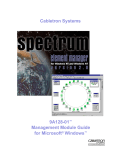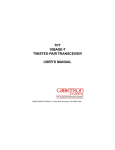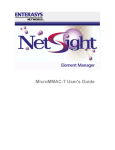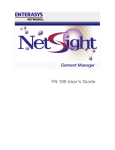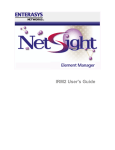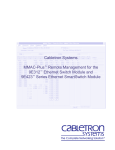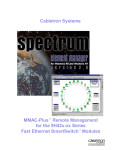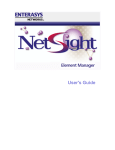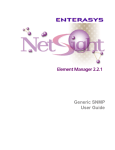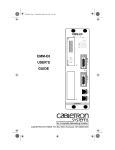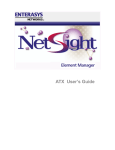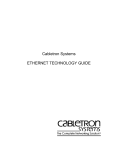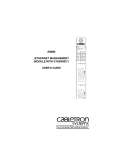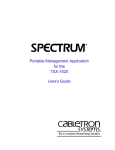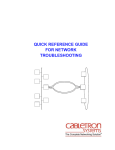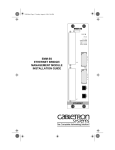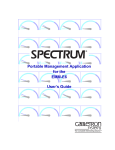Download Cabletron Systems EFDMIM User`s guide
Transcript
GatorMIM and Gator Star User’s Guide Notice Enterasys Networks reserves the right to make changes in specifications and other information contained in this document without prior notice. The reader should in all cases consult Enterasys Networks to determine whether any such changes have been made. The hardware, firmware, or software described in this manual is subject to change without notice. IN NO EVENT SHALL ENTERASYS NETWORKS BE LIABLE FOR ANY INCIDENTAL, INDIRECT, SPECIAL, OR CONSEQUENTIAL DAMAGES WHATSOEVER (INCLUDING BUT NOT LIMITED TO LOST PROFITS) ARISING OUT OF OR RELATED TO THIS MANUAL OR THE INFORMATION CONTAINED IN IT, EVEN IF ENTERASYS NETWORKS HAS BEEN ADVISED OF, KNOWN, OR SHOULD HAVE KNOWN, THE POSSIBILITY OF SUCH DAMAGES. Virus Disclaimer Enterasys has tested its software with current virus checking technologies. However, because no antivirus system is 100% reliable, we strongly caution you to write protect and then verify that the Licensed Software, prior to installing it, is virus-free with an anti-virus system in which you have confidence. Enterasys Networks makes no representations or warranties to the effect that the Licensed Software is virus-free. Copyright 2000 by Enterasys Networks, Inc. All rights reserved. Printed in the United States of America. Order Number: 9031615-04 April 2000 Enterasys Networks P.O. Box 5005 Rochester, NH 03866-5005 Enterasys, NetSight, and Matrix E7 are trademarks of Enterasys Networks. Cabletron Systems, SPECTRUM, BRIM, DNI, FNB, INA, Integrated Network Architecture, LANVIEW, LANVIEW Secure, Multi Media Access Center, MiniMMAC, and TRMM are registered trademarks, and Bridge/Router Interface Modules, BRIM-A100, CRBRIM-W/E, CRXMIM, CXRMIM, Desktop Network Interface, Distributed LAN Monitoring, Distributed Network Server, DLM, DNSMIM, E1000, E2000, E3000, EFDMIM, EMM-E6, EMME, EPIM, EPIM-3PS, EPIM-A, EPIM-C, EPIM-F1, EPIM-F2, EPIM-F3, EPIM-T, EPIM-T1, EPIM-X, ESXMIM, ETSMIM, ETWMIM, FDCMIM-04, FDCMIM-08, FDMMIM, FDMMIM-04, Flexible Network Bus, FOMIM, FORMIM, HubSTACK, IRBM, IRM, IRM-2, IRM-3, Media Interface Module, MicroMMAC, MIM, MMAC, MMAC-3, MMAC-3FNB, MMAC-5, MMAC-5FNB, MMAC-8, MMAC-8FNB, MMAC-M8FNB, MMAC-Plus, MRX, MRXI, MRXI-24, MultiChannel, NB20E, NB25E, NB30, NB35, NBR-220/420/620, RMIM, SecureFast Switch, SecureFast Packet Switching, SFS, SFPS, SPECTRUM Element Manager, SPECTRUM for Open Systems, SPIM-A, SPIM-C, SPIM-F1, SPIM-F2, SPIM-T, SPIM-T1, TPMIM, TPMIM-22, TPMIM-T1, TPRMIM, TPRMIM-36, TPT-T, TRBMIM, TRMM-2, TRMMIM, and TRXI are trademarks of Cabletron Systems, Inc. iii AppleTalk, Apple, Macintosh, and TokenTalk are registered trademarks; and Apple Remote Access and EtherTalk are trademarks of Apple Computer, Inc. SmartBoost is a trademark of American Power Conversion ST is a registered trademark and C++ is a trademark of AT&T Banyan and VINES are registered trademarks of Banyan Systems, Inc. cisco, ciscoSystems, and AGS+ are registered trademarks; and cBus, cisco Router, CRM, IGS, and MGS are trademarks of cisco Systems, Inc. GatorBox is a registered trademark; and GatorMail, GatorMIM, GatorPrint, GatorShare, GatorStar, GatorStar GX-M, and XGator are trademarks of Cayman Systems, Inc. CompuServe is a registered trademark of CompuServe Incorporated X Window System is a trademark of Consortium, Inc. CTERM, DECnet, and ULTRIX are registered trademarks; and DEC, DEC C++, DECnet-DOS, DECstation, VAX DOCUMENT, VMA, and VT are trademarks of Digital Equipment Corporation Fore Systems, ForeRunner, and ForeRunner ASX-100 are trademarks of Fore Systems, Inc. PC/TCP is a registered trademark of FTP Software, Inc. HP OpenView is a registered trademark of Hewlett-Packard, Inc. AIX, IBM, OS/2, NetView, and PS/2 are registered trademarks; and AT, Micro Channel, PC, PC-DOS, PC/XT, Personal Computer AT, Operating System/2, Personal System/2, RISC System/6000, and Workplace Shell are trademarks of International Business Machines Corporation i960 microprocessor is a registered trademark; and Intel and Multichannel are trademarks of Intel Corporation Microsoft, MS-DOS, and Windows are registered trademarks of Microsoft Corporation Chameleon, ChameleonNFS, Chameleon 32, IPX/link, and NEWT are trademarks of NETMANAGE, Inc. NetWare and Novell are registered trademarks; and Internetwork Packet Exchange (IPX), IPX, and Network File System (NFS) are trademarks of Novell, Inc. Motif and MS are registered trademarks; and Open Software Foundation, OSF, OSF/1, and OSF/Motif are trademarks of The Open Software Foundation, Inc. Silicon Graphics and IRIS are registered trademarks; and Indigo and IRIX are trademarks of Silicon Graphics, Inc. NFS, PC-NFS, SPARC, Sun Microsystems, and Sun Workstation are registered trademarks; and OpenWindows, SPARCstation, SPARCstation IPC, SPARCstation IPX, Sun, Sun-2, Sun-3, Sun-4, Sun386i, SunNet, SunOS, SunSPARC, and SunView are trademarks of Sun Microsystems, Inc. OPEN LOOK and UNIX are registered trademarks of Unix System Laboratories, Inc. Ethernet, NS, Xerox Network Systems and XNS are trademarks of Xerox Corporation iv ANNEX, ANNEX-II, ANNEX-IIe, ANNEX-3, ANNEX-802.5, MICRO-ANNEX-XL, and MICROANNEX-ELS are trademarks of Xylogics, Inc. MAXserver and Xyplex are trademarks of Xyplex, Inc. Restricted Rights Notice (Applicable to licenses to the United States Government only.) 1. Use, duplication, or disclosure by the Government is subject to restrictions as set forth in subparagraph (c) (1) (ii) of the Rights in Technical Data and Computer Software clause at DFARS 252.227-7013. Enterasys Networks, 35 Industrial Way, Rochester, New Hampshire 03867. 2. (a) This computer software is submitted with restricted rights. It may not be used, reproduced, or disclosed by the Government except as provided in paragraph (b) of this Notice or as otherwise expressly stated in the contract. (b) This computer software may be: (1) Used or copied for use in or with the computer or computers for which it was acquired, including use at any Government installation to which such computer or computers may be transferred; (2) Used or copied for use in a backup computer if any computer for which it was acquired is inoperative; (3) Reproduced for safekeeping (archives) or backup purposes; (4) Modified, adapted, or combined with other computer software, provided that the modified, combined, or adapted portions of the derivative software incorporating restricted computer software are made subject to the same restricted rights; (5) Disclosed to and reproduced for use by support service contractors in accordance with subparagraphs (b) (1) through (4) of this clause, provided the Government makes such disclosure or reproduction subject to these restricted rights; and (6) Used or copied for use in or transferred to a replacement computer. (c) Notwithstanding the foregoing, if this computer software is published copyrighted computer software, it is licensed to the Government, without disclosure prohibitions, with the minimum rights set forth in paragraph (b) of this clause. (d) Any other rights or limitations regarding the use, duplication, or disclosure of this computer software are to be expressly stated in, or incorporated in, the contract. (e) This Notice shall be marked on any reproduction of this computer software, in whole or in part. v vi Contents Chapter 1 Introduction Using the GatorMIM CS/GatorStar GX-M User’s Guide....................................... 1-2 Related Manuals............................................................................................................ 1-2 Software Conventions .................................................................................................. 1-3 Using the Mouse .................................................................................................... 1-3 Common Gator Module Window Fields............................................................ 1-4 Using Window Buttons......................................................................................... 1-5 Getting Help .................................................................................................................. 1 -5 Using On-Line Help .............................................................................................. 1-5 Accessing On-line Documentation...................................................................... 1-6 Getting Help from the Global Technical Assistance Center ............................ 1-6 Chapter 2 The Gator Module View Viewing Device Information ....................................................................................... 2-2 Front Panel Information........................................................................................ 2-3 Menu Structure....................................................................................................... 2-4 Gator Module Port Status Display ...................................................................... 2-6 The Chassis Manager Window ............................................................................ 2-6 Viewing Hardware Types ..................................................................................... 2-7 Viewing the Device Type ............................................................................... 2-7 Viewing the Module Type ............................................................................. 2-7 Viewing the Port Type.................................................................................... 2-8 Viewing I/F Summary Information.................................................................... 2-8 Interface Performance Statistics/Bar Graphs ............................................. 2-9 Viewing Interface Detail ...............................................................................2-11 Making Sense of Detail Statistics......................................................... 2-13 Enabling and Disabling Ports.................................................................................... 2-14 Chapter 3 LocalTalk and GatorStar Statistics Viewing LocalTalk Statistics ........................................................................................ 3-1 Gator Total Repeater Statistics .................................................................................... 3-3 Index vii Contents viii Chapter 1 Introduction How to use this guide; related guides; software conventions; getting help Welcome to the GatorMIM CS and GatorStar GX-M User’s Guide. We have designed this guide to serve as a reference for using NetSight Element Manager for the GatorMIM CS and the GatorStar GX-M. The GatorMIM CS and GatorStar GX-M are LocalTalk to Ethernet routers—based on Cayman Systems’ GatorBOX-CS technology—which are integrated for use in the MMAC series of intelligent hubs. The GatorMIM CS is a LocalTalk router module for the MMAC hub, providing routing connectivity between LocalTalk and Ethernet topologies with AppleTalk and DECnet routing capabilities, with no configuration required. The GatorStar GX-M is a single module designed to plug into the MMAC hub, providing plug-and-play routing between LocalTalk and Ethernet networks, with no configuration required. It integrates the LocalTalk-Ethernet gateway with the 24-port LocalTalk SmartRepeater. GatorStar GX-M’s SmartRepeater technology provides automatic detection and correction of “jabbering” on LocalTalk ports, and determines the location of individual nodes for each port, allowing network management and mapping programs to determine the location and traffic of every node on your LocalTalk network. Both the GatorStar GX-M and the GatorMIM CS support LocalTalk Statistics and the SNMP System Group. The GatorStar also supports GatorStar Statistics. The GatorStar GX-M can support up to 96 users; the GatorMim CS up to 32 users. 1-1 Introduction Using the GatorMIM CS/GatorStar GX-M User’s Guide Each chapter in this guide describes one major functionality or a collection of several smaller functionalities of the GatorMIM CS and the GatorStar GX-M. This guide contains information about software functions which are accessed directly from the device icon. NOTE The GatorStar GX-M and the GatorMIM CS will be jointly referred to as the Gator Module throughout much of this manual. Where there are differences, each device will be named separately, as necessary. Chapter 1, Introduction, provides a list of related documentation, describes certain software conventions, and shows you how to contact the Global Technical Assistance Center. Chapter 2, The Gator Module View, describes the visual display of the Gator module in the chassis and explains how to use the mouse within the Chassis View. Chapter 3, LocalTalk and GatorStar Statistics, describes both the LocalTalk and Gator Total Repeater Statistics windows, and defines the various packets and errors forwarded across the GatorMIM CS and GatorStar GX-M as well as the total repeater statistics counted by the GatorStar GX-M. Related Manuals The GatorMIM and GatorStar User’s Guide is only part of a complete document set designed to provide comprehensive information about the features available to you through NetSight Element Manager. Other guides which include important information related to managing the Gator Module are as follows: User’s Guide Tools Guide Remote Administration Tools User’s Guide Alarm and Event Handling User’s Guide For more information about the capabilities of the Gator Module, consult the appropriate hardware documentation. 1-2 Using the GatorMIM CS/GatorStar GX-M User’s Guide Introduction Software Conventions Your NetSight Element Manager’s device user interface contains a number of elements common to most windows and which operate the same regardless of the window in which they appear. A brief description of some of the most common elements appears below. The information provided here is not repeated in the descriptions of specific windows and/or functions. Using the Mouse This document assumes you are using a Windows-compatible mouse with two buttons; if you are using a three button mouse, you should ignore the operation of the middle button when following procedures in this document. Procedures within the NetSight Element Manager document set refer to these buttons as follows: Left Mouse Button Right Mouse Button Figure 1-1. Mouse Buttons For many mouse operations, this document assumes that the left (primary) mouse button is to be used, and references to activating a menu or button will not include instructions about which mouse button to use. However, in instances in which right (secondary) mouse button functionality is available, instructions will explicitly refer to right mouse button usage. Also, in situations where you may be switching between mouse buttons in the same area or window, instructions may also explicitly refer to both left and right mouse buttons. Instructions to perform a mouse operation include the following terms: • Pointing means to position the mouse cursor over an area without pressing either mouse button. • Clicking means to position the mouse pointer over the indicated target, then press and release the appropriate mouse button. This is most commonly used to select or activate objects, such as menus or buttons. Software Conventions 1-3 Introduction • Double-clicking means to position the mouse pointer over the indicated target, then press and release the mouse button two times in rapid succession. This is commonly used to activate an object’s default operation, such as opening a window from an icon. Note that there is a distinction made between “click twice” and “double-click,” since “click twice” implies a slower motion. • Pressing means to position the mouse pointer over the indicated target, then press and hold the mouse button until the described action is completed. It is often a pre-cursor to Drag operations. • Dragging means to move the mouse pointer across the screen while holding the mouse button down. It is often used for drag-and-drop operations to copy information from one window of the screen into another, and to highlight editable text. Common Gator Module Window Fields Similar descriptive information is displayed in boxes at the top of most Gator Module windows in NetSight Element Manager, as illustrated in Figure 1-2. Device Name MAC Address IP Address Figure 1-2. Sample Window Showing Informational Boxes Device Name Displays the user-defined name of the device. The device name can be changed via the System Group window; see the Generic SNMP User’s Guide for details. IP Address Displays the device’s IP (Internet Protocol) Address; this will be the IP address used to define the device icon. IP addresses are assigned via local management for the Gator Modules; they cannot be changed via NetSight Element Manager. 1-4 Software Conventions Introduction MAC Address Displays the manufacturer-set MAC address of the device interface. This address is factory-set and cannot be altered. Using Window Buttons The Cancel button that appears at the bottom of most windows allows you to exit a window and terminate any unsaved changes you have made. You may also have to use this button to close a window after you have made any necessary changes and set them by clicking on an OK, Set, or Apply button. An OK, Set, or Apply button appears in windows that have configurable values; it allows you to confirm and SET changes you have made to those values. In some windows, you may have to use this button to confirm each individual set; in other windows, you can set several values at once and confirm the sets with one click on the button. The Help button brings up a Help text box with information specific to the current window. For more information concerning Help buttons, see Getting Help, page 1-5. The command buttons, for example Bridge, call up a menu listing the windows, screens, or commands available for that topic. Any menu topic followed by ... (three dots) — for example Statistics... — calls up a window or screen associated with that topic. Getting Help This section describes different methods of getting help for questions or concerns you may have while using NetSight Element Manager. Using On-Line Help You can use the Gator Module window Help buttons to obtain information specific to the device. When you click on a Help button, a window will appear which contains context-sensitive on-screen documentation that will assist you in the use of the windows and their associated command and menu options. Note that if a Help button is grayed out, on-line help has not yet been implemented for the associated window. From the Help menu accessed from the Module View window menu bar, you can access on-line Help specific to the Module View window, as well as bring up the Chassis Manager window for reference. Refer to Chapter 2, The Gator Module View, for information on the Module View and Chassis Manager windows. Getting Help 1-5 Introduction NOTE All of the online help windows use the standard Microsoft Windows help facility. If you are unfamiliar with this feature of Windows, you can select Help from the Windows Start menu, or Help —> How to Use Help from the primary NetSight Element Manager window. Accessing On-line Documentation The complete suite of documents available for NetSight Element Manager can be accessed via a menu option available from the primary window menu bar: Help—>Online Documents. If you chose to install the documentation when you installed NetSight Element Manager, selecting this option will launch Adobe’s Acrobat Reader and a menu file which provides links to all other available documents. TIP If you have not yet installed the documentation, the Online Documents option will not be accessible from the menu file; in order to activate this option, you must run the setup.exe again to install the documentation component. See your Installation Guide for details. Getting Help from the Global Technical Assistance Center If you need technical support related to NetSight Element Manager, contact the Global Technical Assistance Center via one of the following methods: By phone: (603) 332-9400 24 hours a day, 365 days a year By fax: (603) 337-3075 By mail: Enterasys Networks Technical Support 35 Industrial Way Rochester, NH 03867 By e-mail: [email protected] FTP: ftp.ctron.com (134.141.197.25) Login Password By BBS: Modem Setting 1-6 anonymous your e-mail address (603) 335-3358 8N1: 8 data bits, 1 stop bit, No parity Getting Help Introduction Send your questions, comments, and suggestions regarding NetSight documentation to NetSight Technical Communications via the following e-mail address: [email protected] To locate product specific information, refer to the Enterasys Web site: http://www.enterasys.com NOTE Getting Help For the highest firmware versions successfully tested with NetSight Element Manager 2.2.1, refer to the Readme file available from the NetSight Element Manager 2.2.1 program group. If you have an earlier version of firmware and experience problems, contact the Global Technical Assistance Center. 1-7 Introduction 1-8 Getting Help Chapter 2 The Gator Module View Information displayed in the Module View window; Chassis Manager window; enabling and disabling ports The Gator Module View window is the main screen that immediately informs you of the current configuration of the ports on your Gator Module. Because the Gator Module functions as a stand-alone IMIM (Intelligent Media Interface Module), other MIMs in the MMAC chassis will not be visible. The default Logical View displays the condition of individual ports on the Gator Module; the Physical View provides a graphical representation of the actual board face. The Module View window serves as a single point of access to all other Gator Module windows, which are discussed at length in the following chapter. To access the Gator Module View window, use one of the following options: 1. In any map, list, or tree view, double-click the Gator Module icon you wish to manage; Figure 2-1. Gator Module icon or 1. In any map, list, or tree view, click the Gator Module you wish to manage, and select Manage—>Node from the primary window menu bar, or select the Manage Node toolbar button. or 2-1 The Gator Module View 1. In any map, list, or tree view, click the right mouse button to select the Gator Module you wish to manage, and on the resulting menu, click Manage. Viewing Device Information The Gator Module View window (Figure 2-2) provides a graphic representation of the Gator Module, including a color-coded port display which immediately informs you of the current configuration and status of the ports on the module. Figure 2-2. Module View Window—GatorStar GX-M and GatorMIM CS By clicking in designated areas of the graphical display, or by using the menu bar at the top of the Module View window, you can access device-, board-, and port-level information. TIP 2-2 When you move the mouse cursor over a management “hot spot” the cursor icon changes into a “hand” ( ) to indicate that clicking in the current location will bring up a management option. Viewing Device Information The Gator Module View NOTE Up to 24 ports can be displayed simultaneously on a module. If a module has a higher port density than 24 ports, Up and Down arrows will appear at the top and bottom of the port stack so that you can scroll through the remaining ports. Front Panel Information The section below the main port display provides the following device information: Connection Status This color-coded icon indicates the current state of communication between NetSight Element Manager and the Gator Module. • Green indicates the Gator Module is responding to device polls (valid connection). • Blue indicates an unknown contact status — polling has not yet been established with the Gator Module. • Red indicates the Gator Module is not responding to device polls (device is off line, or device polling has failed across the network for some other reason). UpTime The amount of time, in a days hh:mm:ss format, that the Gator Module has been running since the last start-up. Port Status If management for your device supports a variable port display (see the Gator Module Port Status Display, page 2-6), this field will show the display currently in effect. If only a single port display is available -- or if the default view is in effect -- this field will state Default. MAC The physical layer address assigned to the Gator Module’s Ethernet interface. MAC addresses are hard-coded in the device, and are not configurable. Firmware The revision of device firmware stored in the Gator Module’s FLASH PROMs. Boot Prom, Time, and Date These fields are not supported. IP The Internet Protocol address assigned to the Gator Module is displayed in the title bar; this field will display the IP address you have used to create the Gator Module icon. IP addresses are assigned via Local Management. Viewing Device Information 2-3 The Gator Module View Menu Structure By clicking on various areas of the Gator Module’s Module View display, you can access menus with device-, board-, and port-level options, as well as utility applications which apply to the device as a whole. Figure 2-3 displays the menu structure and indicates how to use the mouse to access the various menus. Device menu for the GatorMIM CS Port menu is available for the GatorMIM CS only Device menu for the GatorStar GX-M Figure 2-3. Gator Module View Menu Structure The Device Menu From the Device Menu at the Module View window menu bar, you can access the following selections: 2-4 • Device Type displays a description of the device being modeled; see Viewing the Device Type, page 2-7, for details. • LocalTalk Statistics displays packets and errors forwarded across the Gator Module in both numeric and pie chart form; see LocalTalk and GatorStar Statistics, in Chapter 3, for more information. • System Group allows you to manage the Gator Module via SNMP MIB II. Refer to the Generic SNMP User’s Guide for further information. Viewing Device Information The Gator Module View • I/F Summary displays statistics for the traffic processed by each network interface on your device; seeViewing I/F Summary Information, page 2-8, for details. • Exit closes the Gator Module View window. In addition to the previously-mentioned selections, the GatorStar GX-M also gives you access to the following selection: • GatorStar Statistics displays total repeater statistics for the GatorStar GX-M in both numeric and pie chart format; see LocalTalk and GatorStar Statistics, in Chapter 3, for more information. The Utilities Menu The Utilities Menu has the following selection: • MIB Tools provides direct access to the device’s MIB information; refer to the Tools Guide for a thorough explanation of the MIB Tools utility. MIB Tools is also available from the Tools menu at the top of NetSight Element Manager’s primary window. The Help Menu The Help Menu has the following three selections: • MIBs Supported opens the Chassis Manager window, see The Chassis Manager Window, page 2-6, for details. • Chassis Manager Help opens a help window with information specifically related to using the Chassis Manager and Module View windows. • About Chassis Manager displays a window with the Chassis Manager version number. The Board Menus The Board menu provides access to the following menu selection: • Module Type displays a description of the selected board; see Viewing the Module Type, page 2-7. The Port Menus The Port menu is available on the GatorMIM CS only, and has the following selections: • Description displays a description of the interface type; see Viewing the Port Type, page 2-8, for details. • Enable/Disable allows you to enable or disable the selected port; see Enabling and Disabling Ports, page 2-14, for details. Viewing Device Information 2-5 The Gator Module View Gator Module Port Status Display The Port Status display varies for each module type. The status conditions for the GatorMIM CS are: ON (Green) The port is on-line and forwarding packets across the Gator Module from one network segment to another. OFF (Red) The port has been disabled by management; no traffic can be received or forwarded on this port. ? (Blue) The status of ports cannot be determined by the software. The status conditions for the GatorStar GX-M are: ENB (Yellow/Enabled) The port is enabled, but not connected to a device; hence, no packets are being forwarded. DIS (Red/Disabled) The port has been disabled by management; no traffic can be received or forwarded on this port. ? (Blue/Unknown) The status of ports cannot be determined by the software. NLK (Yellow/No Link) The port has been disabled automatically because of excessive SWOP, activity, or jabbering. You will be able to re-enable the port when the offending condition no longer exists. The Chassis Manager Window The Chassis Manager window, Figure 2-4, is a read-only window that displays the MIBs and the MIB components — and, therefore, the functionality — supported by the currently monitored device. 1. Select Help—>MIBs Supported in the menu bar. The Chassis Manager window opens. 2-6 Viewing Device Information The Gator Module View The Gator Module does not support MIB Components. The MIBs which provide the Gator Module’s functionality — both proprietary MIBs and IETF RFCs — are listed here Figure 2-4. Chassis Manager Window Viewing Hardware Types Menu options at several levels provide specific information about the physical characteristics of the Gator Module and its ports. Viewing the Device Type The Device Type displays a description of the device being modeled. 1. Select Device—>Device Type in the Module View menu bar. The Device Type window (Figure 2-5) opens. Figure 2-5. Device Type Windows Viewing the Module Type From the Board menu on the Gator Module View window, you can view a description of the Gator Module type. 1. Click on the Board number to reveal the Board menu. 2. Click on Module Type. A Module Type window, similar to the examples shown in Figure 2-6, opens describing the board type. Viewing Device Information 2-7 The Gator Module View Figure 2-6. Sample Module Type Window Viewing the Port Type You can view a brief description of the ports on your Gator MIM CS via the Port menu; this option is not available for Gator Star GX-M ports. 1. Click on the appropriate Port to display the Port menu. 2. Click Description. The Interface Description window, Figure 2-7, opens. Figure 2-7. Sample Interface Description Window Viewing I/F Summary Information The I/F Summary option lets you view statistics for the traffic processed by each network interface on your device. The window also provides access to a detailed statistics window that breaks down Transmit and Receive traffic for each interface. To access the I/F Summary window: 1. Select Device—>I/F Summary on the Module View menu bar. The I/F Summary window, Figure 2-8, opens. 2-8 Viewing Device Information The Gator Module View Figure 2-8. I/F Summary Window The I/F Summary window provides a variety of descriptive information about each interface on your device, as well as statistics which display each interface’s performance. Index The index value assigned to each interface on the device. Type The type of the interface, distinguished by the physical/link protocol(s) running immediately below the network layer (e.g., ethernet-csmacd). Description A text description of the interface. Physical Status Displays the current physical status — or operational state — of the interface: Online or Offline. Logical Status Displays the current logical status — or administrative state — of the interface: Up or Down. Interface Performance Statistics/Bar Graphs The statistical values (and, where available, the accompanying bar graphs) to the right of the interface description fields provide a quick summary of interface performance. You can select the statistical value you want to display and the units in which you want those values displayed by using the two menu fields directly above the interface display area, as follows: Viewing Device Information 2-9 The Gator Module View 1. In the right-most menu field, click to select the unit in which you wish to display the selected statistic: Load, Raw Counts, or Rate. NOTE Bar graphs are only available when Load is the selected base unit; if you select Raw Counts or Rate, the Bar Graph column will be removed from the interface display. 2. Once you have selected the base unit, click in the left-most field to specify the statistic you would like to display. Note that the options available from this menu will vary depending on the base unit you have selected. After you select a new display mode, the statistics (and graphs, where applicable) will refresh to reflect the current choice, as described below. Raw Counts The total count of network traffic received or transmitted on the indicated interface since device counters were last reset. Raw counts are provided for the following parameters: 2-10 In Octets Octets received on the interface, including framing characters. In Packets Packets (both unicast and non-unicast) received by the device interface and delivered to a higher-layer protocol. In Discards Packets received by the device interface that were discarded even though no errors prevented them from being delivered to a higher layer protocol (e.g., to free up buffer space in the device). In Errors Packets received by the device interface that contained errors that prevented them from being delivered to a higher-layer protocol. In Unknown Packets received by the device interface that were discarded because of an unknown or unsupported protocol. Out Octets Octets transmitted by the interface, including framing characters. Out Packets Packets transmitted, at the request of a higher level protocol, by the device interface to a subnetwork address (both unicast and non-unicast). Out Discards Outbound packets that were discarded by the device interface even though no errors were detected that would prevent them from being transmitted. A possible reason for discard would be to free up buffer space in the device. Viewing Device Information The Gator Module View Out Errors Outbound packets that could not be transmitted by the device interface because they contained errors. Load The number of bytes processed by the indicated interface during the last poll interval in comparison to the theoretical maximum load for that interface type (10 Mbps for standard Ethernet). Load is further defined by the following parameters: In Octets The number of bytes received by this interface, expressed as a percentage of the theoretical maximum load. Out Octets The number of bytes transmitted by this interface, expressed as a percentage of the theoretical maximum load. When you select this option, a Bar Graph field will be added to the interface display area; this field is only available when Load is the selected base unit. Rate The count for the selected statistic during the last poll interval. The available parameters are the same as those provided for Raw Counts. Refer to the Raw Counts section, page 2-10, for a complete description of each parameter. Viewing Interface Detail The I/F Statistics window provides detailed statistical information — counts for both transmit and receive packets, and error and buffering information — for each individual interface. Color-coded pie charts also let you graphically view statistics for both received and transmitted Unicast, Multicast, Discarded, and Error packets. To open the Interface Statistics window: 1. In the I/F Summary window, click to select the interface for which you would like to view more detailed statistics. 2. Click Detail. The appropriate I/F Statistics window, Figure 2-9, opens. Viewing Device Information 2-11 The Gator Module View Figure 2-9. Interface Detail Window Three informational fields appear in the upper portion of the window: Description Displays the interface description for the currently selected interface. Address Displays the MAC (physical) address of the selected interface. Type Displays the interface type of the selected port (e.g., ethernet-csmacd). The lower portion of the window provides the following transmit and receive statistics. The first four statistics are also graphically displayed in the pie charts. Unicast Displays the number of packets transmitted to or received from this interface that had a single, unique destination address. These statistics are displayed in the pie chart, color-coded green. Non-Unicast Displays the number of packets transmitted to or received from this interface that had a destination address that is recognized by more than one device on the network segment. The multicast field includes a count of broadcast packets — those that are recognized by all devices on a segment. These statistics are displayed in the pie chart, color-coded dark blue. 2-12 Viewing Device Information The Gator Module View Discarded Displays the number of packets which were discarded even though they contained no errors that would prevent transmission. Good packets are typically discarded to free up buffer space when the network becomes very busy; if this is occurring routinely, it usually means that network traffic is overwhelming the device. To solve this problem, you may need to re-configure your bridging parameters, or perhaps re-configure your network to add additional bridges or switches. These statistics are displayed in the pie chart, color-coded magenta. Error Displays the number of packets received or transmitted that contained errors. These statistics are displayed in the pie chart, color-coded red. Unknown Protocol (Received only) Displays the number of packets received which were discarded because they were created under an unknown or unsupported protocol. Packets Received (Received only) Displays the number of packets received by the selected interface. Transmit Queue Size (Transmit only) Displays the number of packets currently queued for transmission from this interface. The amount of device memory devoted to buffer space, and the traffic level on the target network, determine how large the output packet queue can grow before the MRXI will begin to discard packets. Packets Transmitted (Transmit only) Displays the number of packets transmitted by this interface. Making Sense of Detail Statistics By using a few simple calculations, the I/F Statistics window can give you an idea of the interface’s activity level and how the interface is performing . To calculate the percentage of input errors: Received Errors /Packets Received To calculate the percentage of output errors: Transmitted Errors /Packets Transmitted To calculate the total number of inbound and outbound discards: Received Discards + Transmitted Discards To calculate the percentage of inbound packets that were discarded: Received Discards /Packets Received Viewing Device Information 2-13 The Gator Module View To calculate the percentage of outbound packets that were discarded: Transmit Discards /Packets Transmitted NOTE The Interface Statistics window does not offer Disable or Test options. These options are available in the Interface Group window, which can be accessed via the System Group window (select System Group from the Device menu). Refer to your Generic SNMP User’s Guide for more information on the System Group and Interface Group windows. Enabling and Disabling Ports From the Port menus on the GatorMIM CS Module, you can enable and disable any individual ports. To enable or disable a port: 1. Click on the desired Port to display the Port menu. 2. Click Enable to enable the port, or Disable to disable the port. Your port will now be enabled or disabled as desired. 2-14 Enabling and Disabling Ports Chapter 3 LocalTalk and GatorStar Statistics LocalTalk Statistics window; Total Repeater Statistics window Viewing LocalTalk Statistics The LocalTalk Statistics window (Figure 3-1) displays accumulated statistics and error breakdowns at the device level for the LocalTalk side of the Gator module. Statistics are displayed in numeric form and in graphic form as a pie chart. 1. Select Device—>LocalTalk Statistics in the Module View menu bar. The LocalTalk Statistics window, as shown in, Figure 3-1, opens. Figure 3-1. LocalTalk Statistics 3-1 LocalTalk and GatorStar Statistics The following packet and error statistics appear within the LocalTalk Statistics window: Packets Fields The Packet Fields display general performance information on the LocalTalk interface are as follows: In Packets The total number of good packets received by the LocalTalk interface. Out Packets The total number of packets transmitted from the LocalTalk interface. Hard Errors Hard errors are error conditions caused by physical layer problems, such as faults in the hardware, equipment, or wiring. Hard error fields are as follows: In Errors The total number of packets containing errors received on the LocalTalk interface. In Errors are color-coded magenta. Collisions The total number of collisions assumed on the LocalTalk interface due to the lack of a lapCTS (link access protocol Clear To Send) reply. Collisions are color-coded red. Soft Errors Soft errors are error conditions caused by corrupted data signals, such as failure along the transmission path. Soft error fields are as follows: 3-2 In No Handlers The total number of good packets received on the LocalTalk interface for which there was no protocol handler. In No Handlers are color-coded green. In Length Errors The total number of packets received on the LocalTalk interface in which the actual packet length did not match the length specified in the header. In Length Errors are color-coded yellow. Defers The total number of times the LocalTalk interface deferred to other packets (postponed sending a packet until after packets from other ports had already been sent). This usually indicates that the network was busy when the port wanted to send data. The link has to be idle for at least 400 microseconds before it will start to transmit. No Data Errors The total number of times the LocalTalk interface received a lapRTS (link access protocol Request To Send) packet and expected a data packet, but did not receive any data packets. Viewing LocalTalk Statistics LocalTalk and GatorStar Statistics Random CTS Errors The total number of times the LocalTalk interface received a lapCTS packet that was not solicited by a lapRTS packet. FCS Errors The total number of times the LocalTalk interface received a packet with an FCS (Frame Check Sequence) error. When a packet is transmitted, the MAC layer of the transmitting device computes an FCS value based on the contents of the packet, and appends that value to the packet. The receiving station performs the same computation. If the FCS values differ, the packet is assumed to be corrupted. Gator Total Repeater Statistics The Gator Total Repeater Statistics window displays the total number of repeater statistics and error breakdowns at the device level for the GatorStar GX-M only. The pie chart to the right of the statistics text boxes allows you to graphically view the statistics. By using the Total and Delta option buttons, you can change the time period during which statistical data is collected. Total gathers data from the device and updates it at each subsequent polling interval. After the completion of the current polling cycle plus one complete polling cycle, the window will display the sum of statistics processed since the device was last restarted. Delta gathers data during the last polling interval (after the completion of the current polling cycle plus two more polling cycles). These counts are refreshed after each polling cycle. 1. Select Device—>GatorStar Statistics in the Module View menu bar. The Gator Total Repeater Statistics window, Figure 3-2, opens. Figure 3-2. Gator Total Repeater Statistics Window Gator Total Repeater Statistics 3-3 LocalTalk and GatorStar Statistics The following fields appear within the Gator Total Repeater Statistics window: Packets Fields Total Packets Error Fields Total Jabbers 3-4 The total number of packets processed by the device since the last reset. Total Packets are color-coded green. The total number of packets since the last reset that were oversized (greater than 1518 bytes — a Giant packet), and had either a non-integral number of bytes (alignment error) or a bad frame check sequence (CRC error). Total Jabbers are color-coded yellow. Total Swops The total number of SWOP (Sync Without Packet) conditions since the last reset. Total Swops are color-coded magenta. Spurious Interrupts The total number of spurious (invalid) interrupts on the device since the last reset. Received Packets The total number of good packets received with no errors since the last reset. Too Long Packets The total number of packets greater than the maximum allowable number seen on the device since the last reset. Alignment Errors The total number of misaligned packets seen on the device since the last reset. A misaligned packet is one that does not contain an integral number of bytes. Received Aborts The number of packets that were aborted during the receive process since the last reset. CRC Errors The total number of packets with CRC (Cyclical Redundancy Check) errors seen on the device since the last reset. CRC errors occur when the element responsible for either the transmit or receive CRC calculation is malfunctioning, which causes good packets to be discarded as errors. Overrun Errors The total number of overrun conditions seen on the device since the last reset. An overrun occurs when the processor cannot keep up with the inbound byte stream. CD Lost The total number of CD Lost (Carrier Detect Lost) errors seen on the device since the last reset. Gator Total Repeater Statistics Index A G Alignment Errors 3-4 GatorMIM CS 1-1 GatorStar GX-M 1-1 GatorStar Statistics 2-5 Global Technical Assistance Center 1-6 B Board Menus 2-5 Boot Prom revision 2-3 Buffer space 2-13 C Cancel button 1-5 Carrier Detect Lost 3-4 CD Lost 3-4 Clear to send 3-2 Collisions 3-2 Color-coded port display 2-2 Command buttons 1-5 Connection Status 2-3 CRC Errors 3-4 D Defers 3-2 Delta 3-3 Device 1-4 Device Menu 2-4 Device name 1-4 Device Type 2-4, 2-7 Disabling a port 2-14 Discarded packets 2-13 H Help button 1-5 Help Menu 2-5 I I/F Summary window 2-9 interface description fields 2-9 interface performance statistics 2-9 In Errors 3-2 In Length Errors 3-2 In No Handlers 3-2 In Packets 3-2 Interface Group window 2-11 IP address 1-4, 2-3 L Load 2-11 LocalTalk Statistics 2-4 Logical Status 2-9 M E MAC address 1-5, 2-3 Menu structure 2-4 Mouse usage 1-3 Multicast (Non-Unicast) 2-12 Enabling a port 2-14 Exit 2-5 N F No Data Errors 3-2 Non-Unicast (Multicast) 2-12 FCS Errors 3-3 firmware versions 1-7 Index-1 Index O V OK button 1-5 Out Packets 3-2 Overrun Errors 3-4 View 2-1 P Packets Received 2-13 Packets Transmitted 2-13 Physical Status 2-9 Port display color codes 2-2 Port Menus 2-5 Port type 2-8 R Random CTS Errors 3-3 Rate 2-11 Raw Counts 2-10 Readme 1-7 Received Aborts 3-4 Received Packets 3-4 Request to send 3-2 S Set button 1-5 Soft Errors 3-2 Spurious Interrups 3-4 Status conditions 2-6 Sync without packet 3-4 System Group 2-4 T Technical support 1-6 Too Long Packets 3-4 Total 3-3 Total Jabbers 3-4 Total Packets 3-4 Total Repeater Statistics 3-3 Total Swops 3-4 Transmit Queue Size 2-13 U Unicast 2-12 Unknown Protocol 2-13 UpTime 2-3 Utilities Menu 2-5 Index-2




































